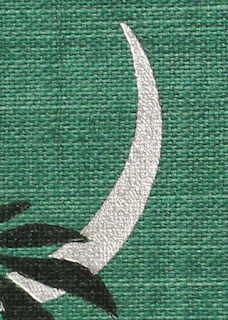Thomas Watson Ball
The Goodness of Saint Rocque
by Alice Dunbar
(Dodd, Mead & Co., 1899)
17.5 x 11.3 cm.
The wonderful thing about this cover art is the illusion of the reflection of the crescent moon on the water seeming to illuminate the surface coming toward the viewer in perspective.
This photo doesn't capture the scintillating glitter of the sea--it's a great effect, created by texturing the stamping die microscopically so the silver stamping reflects at different angles in the crescent moon and in the ripples on the sea. This can be seen by examining the stamping with a 10X loupe.
The next three photos show the details. The effect is different on the lettering, which has a texture from the fine weave cloth, and no added texture from the stamping die:
The next three photos show the details. The effect is different on the lettering, which has a texture from the fine weave cloth, and no added texture from the stamping die:
The stamping is of course not silver, but likely aluminum in 1899--it was a precious metal until Hall and Bayer developed methods of extracting it around 1889 --silver leaf wasn't used for book cover stamping because it tarnishes. White gold is also a possibility. In the late 20th century Palladium leaf became popular with bookbinders.
Below is the same book with a slight change in lighting:













It would be interesting to find out what the metal was. I've been reading a bit about aluminum in the nineteenth century. It plummeted in price from over $500 a pound in the mid nineteenth century to $2.00 a pound at the end. In 1884, an once of aluminum cost $1, the same as an average day laborer's salary. Somewhat coincidently, it was Andrew Mellon (the Mellon foundation well know today for its funding of conservation) who founded the aluminum monopoly which later became Alcoa, beginning in 1888. Maybe a Mellon intern could do the analysis gratis!
ReplyDeleteThanks, Jeff. I didn't know Mellon was involved in the Pittsburgh Reduction Company, which later became Alcoa. My understanding is that it was founded in 1888 by Charles Martin Hall, the American chemist who discovered the process in 1886, with financier Alfred E. Hunt. Hall was awarded a US Patent for his process in 1889.
Deletehttp://www.oberlin.edu/external/EOG/OYTT-images/CMHall.html
http://inventors.about.com/library/inventors/blaluminum.htm
A Frenchman, Paul L. T. Héroult, also discovered that Cryolite was a non-conducting solvent for aluminum in 1886. In 1888 the Austrian Karl Joseph Bayer discovered another process for separating Aluminum from Bauxite.
-R